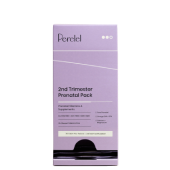Did you know one in eight couples experience infertility? For so many, the path to parenthood simply isn't a straight line—and yet when chatting with our community about navigating fertility challenges, one of the most common things we hear is how isolating this experience can feel.
So beyond normalizing it by the numbers, let's help shed some light on what infertility really looks like—and how we can navigate this frustrating experience.
What is infertility?
Infertility is characterized by the failure to achieve pregnancy after 12 months or more of regular unprotected sex. For women over 35, however, the inability to conceive after six months of unprotected intercourse is generally considered infertility.1,2
What causes infertility?
This is crucial: There are a number of factors that can cause or contribute to infertility, in both men and women. In females, infertility may be the result of abnormalities of the ovaries, uterus, fallopian tubes and the endocrine system, and other parts of the reproductive system. In males, infertility is typically caused by problems in the ejection of semen, the lack of—or low levels of—sperm, or abnormal shape and movement of the sperm.
How common is infertility?
Infertility impacts between 10 to 15 percent of couples, making it one of the most common diseases for people between 20 and 45 years of age. And here's your cursory reminder that TTC if 50/50—and infertility isn’t just an issue for women. In fact, approximately one-third of infertility cases are caused by women's problems and one third are due to the man. The other third are due to a mixture of male and female problems—or by unknown problems. (This is known as "unexplained infertility.")3,4
What are the types of infertility?
There are two different types of infertility: primary and secondary. Here’s how they’re defined:
- Primary infertility: When a pregnancy has never before been achieved.
- Secondary infertility: When at least one prior pregnancy has been achieved.
What are the risk factors for infertility in both genders?
There are certain risk factors for infertility that apply to both genders. These include:
- Age—women aged over 35 and men over 40 are at increased risk
- Diabetes
- Eating disorders, including anorexia nervosa and bulimia
- Excessive alcohol consumption
- Exposure to environmental toxins like lead and pesticides.
- Excessive exercising
- Radiation therapy
- Sexually transmitted diseases (STDs)
- Smoking
- Stress
- Substance abuse
- Obesity
- Underweight
What are the risk factors for infertility in women?
In addition to the risks of infertility for both genders listed above, there are risk factors specific to females, like:5,6
- Abnormal menstruation
- Blocked fallopian tubes
- Celiac disease
- Kidney disease
- Prior ectopic (tubal) pregnancy
- Pelvic inflammatory disease
- Pituitary gland disorders like Cushing’s syndrome
- Polycystic ovary syndrome (PCOS),ovarian cysts and primary ovarian insufficiency
- Sickle cell anemia
- Uterine complications like endometriosis,uterine fibroids and uterine polyps
- Thyroid disease
What are the risk factors for infertility in men?
These are also risk factors for infertility that are specific to males:
- Enlarged veins (varicocele) in the scrotum
- Genetic disorders, such as cystic fibrosis
- High heat exposure to testicles
- Injury to the scrotum or testicles
- Low sperm count or low testosterone
- Misuse of anabolic steroids
- Premature ejaculation or retrograde ejaculation
- Testicular cancer and associated treatments
- Undescended testicles
How is infertility diagnosed in men and women?
If you've been trying to conceive for over a year (or 6 months, if you're over 35 or have an inflammatory condition), it might be time to check in with a fertility specialist. There are a variety of gender-specific tests she may recommend, including:
- Pelvic exam: Coupled with a Pap smear, this exam will help your provider determine if there are any structural issues or signs of disease that need to be addressed.
- Blood test: This test will uncover any abnormal hormone levels, including your thyroid hormones.
- Transvaginal ultrasound: This is an internal ultrasound that enables your provider to identify any problems with the reproductive system.
- Hysteroscopy: This involves having a thin, lighted tube inserted into your vagina so your doctor can examine your uterus.
- Saline sonohysterogram (SIS): With this test, your provider will fill the uterus with saline before performing a transvaginal ultrasound—a full uterus makes it easier for your doctor to see inside it.
- Hysterosalpingogram (HSG): This test helps your doctor determine if there are any blockages in your fallopian tubes via X-rays that capture an injectable dye as it travels through your
- Laparoscopy: This test helps your healthcare provider identify problems like endometriosis, uterine fibroids and scar tissue. It involves having a thin tube with a camera attached inserted into a tiny abdominal incision.
For men, the following tests can help diagnose or rule out fertility issues:11
- Semen analysis: For most men, this is the only test needed to identify fertility issues. It checks for problems with sperm, including low sperm count and poor mobility, two of the most common causes of infertility in males.
- Blood test: This can help check testosterone, thyroid and other hormone levels. There are also genetic blood tests, which can help identify chromosomal abnormalities.
- Scrotal ultrasound: This helps your provider determine if there are abnormalities with the testicles.
- Testicular biopsy: This is an invasive procedure where your provider takes a small sample of testicular tissue in order to diagnose specific conditions.

What are the steps for treating infertility?
There are a variety of treatments for infertility, but the best one for you depends upon a number of factors, including the cause of your challenges, how long you’ve experienced issues, your age and your partner’s age. Your comfort level with each option is also an important consideration, and one that should be discussed with your partner and in some cases, your doctor.
For some women, fertility is improved by one type of treatment. For others, a combination of therapies is required. Here is an overview of some of the most common treatment options for women experiencing infertility:
- Hormone therapy: This approach is often prescribed for women with a hormone imbalance, endometriosis or short menstrual cycle.
- Medication: Certain medications can help regulate or stimulate ovulation in women who are infertile due to ovulation disorders. Antibiotics may also be prescribed if an infection is to blame.
- Surgery: If a woman has blockages, scar tissue, fibroids or adhesions in her fallopian tubes, uterus or pelvic area, surgery may be the best option.
- Intrauterine insemination (IUI): This involves healthy sperm being placed directly in the uterus around the time of ovulation.
For men struggling with infertility, medications, surgery or sperm retrieval may be prescribed. Changing certain behaviors or habits may also help improve fertility. Discontinuing certain medications, eliminating harmful substances, increasing the frequency and optimizing the timing of intercourse, and exercising regularly are just some of the changes that may support male fertility.
Assisted Reproductive Technology
For some couples struggling with infertility, Assisted Reproductive Technology (ART) is the best option. Although there are a few different definitions for ART, according to the Centers for Disease Control and Prevention (CDC),7 this term describes any fertility treatment in which either eggs or embryos are handled.
ART procedures typically involve surgically removing eggs from a woman’s ovaries, combining them with sperm in a laboratory, and returning them to the woman’s body—or donating them to another woman. Treatments in which only sperm are handled, like IUI or artificial insemination, or procedures in which a woman takes medicine to promote ovulation without the intention of having the eggs retrieved are not considered ART by this definition .
In vitro fertilization (IVF), which involves stimulating and retrieving multiple mature eggs, fertilizing them with sperm in a dish in a lab, and implanting the embryos in the uterus several days after fertilization, is the most common ART technique.
How Do You Deal With Your Results?
You might not get the news you wanted. Remember that a single test result doesn’t necessarily determine whether you can get pregnant. Your doctor can keep working to get answers for you.
Here are some other ways to take care of yourself:
-
Turn to your closest friends and family for support—especially anyone who’s dealt with fertility issues.
-
Talk to a therapist who can give you the emotional support you need during this process.
-
Get enough sleep, eat a nutrient-rich diet, keep moving, and go easy on the alcohol. This can help support your mental health.
-
Try to be understanding and patient with yourself. It’s common to feel all sorts of emotions—depressed, stressed, envious, or even relieved.
-
If it’s all feeling too hard, take a break and re-visit it all in the future—or don’t!
Some folks who are infertile at one point can get pregnant later on without any treatment, so factor that into your birth control decisions.
Can you prevent infertility?
In instances where infertility is the result of genetic problems or illness, not much can be done to reverse it. But there are a number of things you can do if you’re struggling with infertility caused by other issues, like:
- Achieve and maintain a healthy weight
- Stop smoking
- Abstain or limit alcohol
- Minimize stress
- Avoid exposure to pesticides, heavy metals and toxins
- Refrain from using illicit drugs
- Men should avoid prolonged heat exposure for the testicles and should not undergo a vasectomy
Women and men can also set themselves up for conception and pregnancy by optimizing their nutritional intake, and prioritizing nutrients that support egg health, sperm health, and overall wellbeing. Our Conception Support Pack* was created in partnership with leading fertility experts to prepare your body for pregnancy and support ovarian function with antioxidant support, added omegas, additional folate and a full-spectrum prenatal vitamin. Our Men's Multi Support Pack* contains nutrients like CoQ10 to support his reproductive and general health. And we recently launched our Fertility+ Support for those fertility journeys that might need a little extra help.
Shop the Article:
Will insurance cover infertility treatments?
Whether or not your insurance will cover fertility treatments depends on the type of insurance plan you have as well as where you live—14 U.S. states currently have laws in place requiring insurance companies to cover or offer to cover some form of infertility diagnosis and treatment.8 Here’s a list of them:
- Arkansas
- California
- Connecticut
- Hawaii
- Illinois
- Maryland
- Massachusetts
- Montana
- New Jersey
- New York
- Ohio
- Rhode Island
- Texas
- West Virginia
For more information about the laws in your state, contact your state's Insurance Commissioner's office or your State Representatives.
If you or someone you know is struggling with infertility, check out our series Fertility, Unfiltered, where we share the unspoken stories of fertility. From egg freezing to IVF, no topic is off-limits.
References:
- Who.int. 2022. Infertility.
- Reproductivefacts.org. 2022. Defining Infertility.
- Mayo Clinic. 2022. Infertility - Symptoms and causes.
- Womenshealth.gov. 2022. Infertility | Office on Women's Health.
- Cleveland Clinic. 2022. Infertility Causes: Types, Risk Factors, Diagnosis & Treatment.
- Mayoclinic.org. 2022. Infertility - Diagnosis and treatment - Mayo Clinic.
- Cdc.gov. 2022. What is Assisted Reproductive Technology?.
- Reproductivefacts.org. 2022. Q08: Do Insurance Plans Cover Infertility Treatment?.
- The Emotions of Infertility. (2022d, June 13).. American Pregnancy Association. https://americanpregnancy.org/getting-pregnant/emotions-of-infertility
-
Fertility Test for Women. (2022b, June 10). American Pregnancy Association. https://americanpregnancy.org/getting-pregnant/fertility-test-for-women/






























